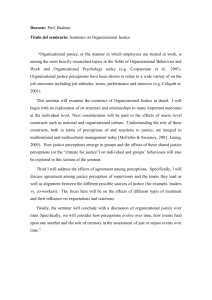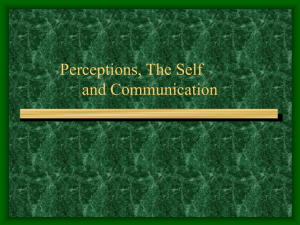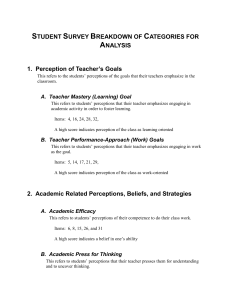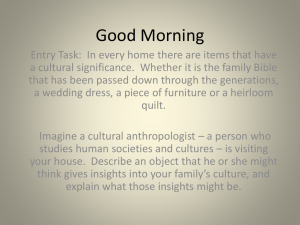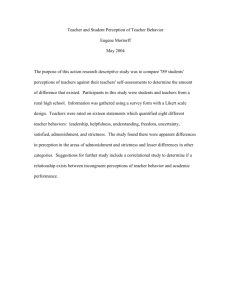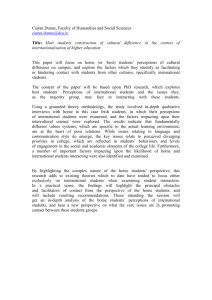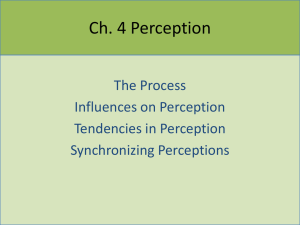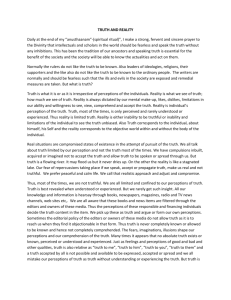Perceiving Others
advertisement
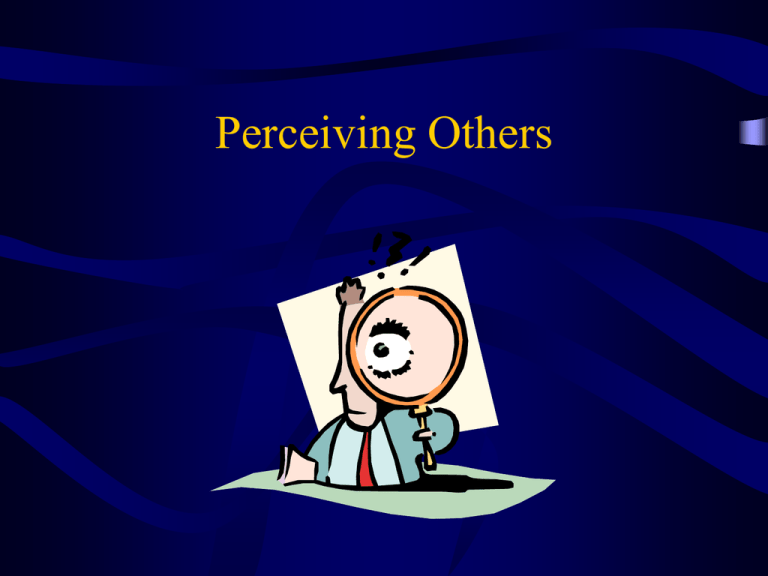
Perceiving Others Try to connect all of these nine dots using no more than four straight lines, which must be connected to one another… Perception: • Selection • Organization • Interpretation Selection – We pay attention to things that… • Stand out: • Larger • More intense • More unusual • We have an emotional reaction to • Have personal significance But be careful not to oversimplify… Organization – Making sense of what we’ve noticed Perceptual Schema Here’s one way to look at this… • Physical constructs • Role constructs • Interaction constructs • Psychological constructs Or here’s another… • Prototypes • Personal constructs • Stereotypes • Punctuation • Scripts Interpretation – Attaching meaning to what we’ve constructed • Degree of Involvement • Relational Satisfaction • Past Experience • Assumptions about Human Behavior • Expectations • Knowledge of others Influences on Perception Physiological Influences • The Senses • Age • Health • Fatigue • Hunger • Biological Cycles Psychological Influences • Mood • Self-Concept Cultural Influences • Different cultures have different perceptions of: – Independence vs. Interdependence – Silence vs. Extroversion – Eye-contact or no Eye-contact – Other cultures (stereotypes) – The world and their place in it For example… Social Influences • Gender Roles • Occupational Roles • Shared Narratives • Gender Roles Undifferentiated Masculine Feminine Androgynous • Occupational Roles – Have you had your job influence your perceptions? – Does your major influence your perceptions? • Shared Narratives – Perceptions of the world that we construct with others Perception is an interactive process Others’ perceptions of people and situations influence our perceptions, and vice versa. The Trouble with Perceptions… Some common perceptual mistakes • We tend to judge others more harshly than we do ourselves – We tend to have a self-serving bias, especially in conflicts – Important to check to see how accurate our appraisal is • We pay attention to the obvious, and may not perceive other factors that are less obvious • We form first impressions quickly, and don’t let go of them – Halo (or horns?) effect – Important to keep an open mind, and to allow your impressions to change • We tend to assume others are just like us – Important to ask, check with others, &/or examine your assumptions • We tend to focus on negative impressions of others Some Suggestions for Improving Perceptions • Recognize that all perceptions are subjective • Avoid mindreading (e.g., “I know why you’re upset,” “I know how you feel,” “Why are you mad at me?”) • Distinguish between facts and inferences (This person “is” vs. “seems”) • Monitor the self-serving bias • Monitor labels And… • Check your perceptions! – A complete perception check has 3 parts: • A nonjudgmental description of the behavior you observed • Two possible interpretations of the behavior • A request for clarification about how to interpret the behavior “You bit my head off when I came in the door. You’re still angry about last night aren’t you?” Vs. “You started asking me a lot of questions when I got home tonight, and there was something about the look on your face that made me wonder if you’re mad at me. But maybe you just had a bad day today. What’s on your mind? And… “Do Not judge a man (or woman) until you walk a mile in his (or her) moccasins.” • Exercise your empathy skills! – Empathy involves: • • • – – – Perspective taking: “What might this other person be thinking? What is their situation? Where would I be walking if I were walking in their shoes?” Emotional contagion: “What might this other person be feeling? How would that feel for me? What would it feel like to walk in this person’s shoes? Are there any rocks in their shoes?” Concern for the welfare of the other person Keep an open mind Use your imagination (empathy isn’t easy) Make a commitment to be empathetic
